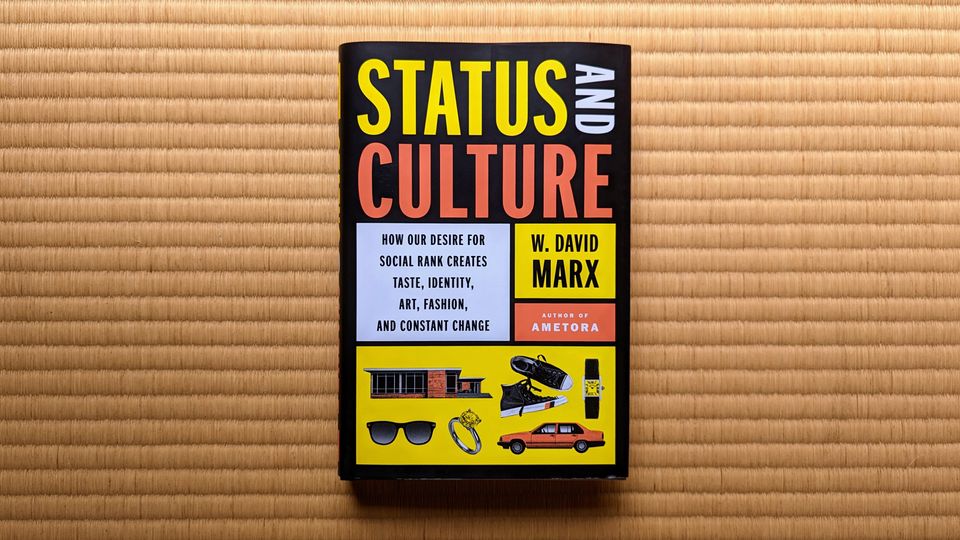My New Book: Status and Culture

A sneak peek into my new book that links individuals’ fundamental desire for social status to the formation of taste, identities, class-based aesthetics, subcultures, artistic movements, fashion trends, and historical continuity, and the ephemerality of Internet culture
On September 6, Viking will publish my second book, Status and Culture: How Our Desire for Social Rank Creates Taste, Identity, Art, Fashion, and Constant Change. You can pre-order it here from a variety of booksellers.
Status and Culture is my attempt to solve what I call The Grand Mystery of Culture: Why do humans collectively prefer certain practices, and then years later, move on to alternatives for no practical reason? Put another way: What is culture, where does it come from, and why does it change?
In order to get to the bottom of this mystery, I needed to synthesize the most famous ideas on culture in sociology, anthropology, economics, philosophy, linguistics, semiotics, literary theory, art history, media studies, and neuroscience. The key concept guiding the mechanics of cultural change and formation, I eventually realized, is status — more specifically, the fundamental human desire for higher social rank. The book explains how status guides our particular lives in predictable ways and how this results in clusters of culture arising at a macro level.
In 273 pages (and 1,200+ endnotes), I chart out how the core principles of status and culture work together in a single system, illustrated by examples such as The Beatles’ moptops, Lassie, Coco Chanel, James Baldwin, William Finnegan's surfboards, John Waters, Liz Phair and Liz Phair, tuxedos in the Whit Stillman film Metropolitan, Beck’s “Loser” years, grain silos, Billie Holiday, gourmet cupcakes, Jacob the Jeweler, Cartier tank watches, yuppies, Beat poets, Rastafarians, Teddy Boys, gyaru, "Doctorin' the Tardis," chocolate, Emperor Nero, and the ‘50s retro vocal group, Sha Na Na. (Although no specific Bowzer references.)
To give you a full sense of what the book covers, here is a detailed summary of the contents:
- Status: I start by explaining the “rules” of how social status works — the inner logic of how individuals compete for position within hierarchies. We’re not “status monkeys” doomed by evolutionary psychology: If a higher position comes with more social benefits, it’s rational to seek elevation. In contemporary societies, status competition focuses around the acquisition of capital. When individuals disagree on the proper basis for status, they split into rival status groups.
- Conventions: Culture consists of conventions — well-known, regular, accepted social behaviors that individuals follow and expect others to follow. Despite an arbitrariness at their core, conventions become habitual, normative, and alter our perception of the world. The particular social position of adopters give conventions differential social values (i.e. “status value”), and we end up aspiring towards higher-status conventions. Within any group, we’re required to follow conventions of our peers and reject conventions of our rivals. We theoretically are able to adopt an infinite possibility of cultural behaviors, but status makes certain practices valuable and others damaging to our standing.
- Signaling: In order to gain status from strangers, we have to publicly demonstrate our engagement with high-status conventions. Culture is thus always symbolic, which creates its own communication problems and opens the potential for cheating.
- Taste: We judge other people’s status based on triangulating their cultural choices as their taste, and the implied status position of our taste becomes integral to how we are identified. A key requirement to gain status through our tastes is authenticity, as we should always make cultural choices that reflect our “real” backgrounds.
- Class: Socioeconomic classes (groups of individuals with similar capital) gravitate towards certain aesthetics as a direct result of status struggle: New Money conspicuous consumption, Old Money patina, professional class sophistication, etc.
- Subcultures and countercultures: To break off from core society, alternative status groups must create radical new conventions, and as those in the creative class imitate these new conventions, they go on to influence wider society.
- Art: Creators need “artist status” in order for their work to be perceived as "art," and the status struggles between artists is a reliable source of radical cultural innovation. Regular status also plays a major role in turning artistic innovations into widely-held conventions.
- Fashion cycles: Lower-status individuals imitate higher-status individuals’ conventions, which diffuses them across society, but also spurs further elite distinction. Status thus creates a perpetual motion machine of cultural creation.
- History: Higher-status individuals have greater influence on what is “remembered” in society: e.g. habits, traditions, and the “canon.” Retro, an inevitable byproduct of fashion cycles, has also emerged as an alternative means of historical memory.
- The Internet age: The proliferation of viral and “Long Tail” content, constant signaling on social media, hyper-speed of fashion cycles, the rise of new New Money, and rejection of taste among creative elites all conspire towards an evaporation of status value for new conventions. Nothing “sticks,” which explains both the retromania of older consumers and the TikTok neomania of younger ones.
In writing this book, I realized so much of this well-established knowledge about human behavior is buried in obscure corners of the academic literature and fully missing from our formal educational curriculum. But no matter who you are, Status and Culture will provide many new ways to think about your self and your relation to society, as well as better understand why culture changes (or doesn't). Status and culture play a major role in our lives, but more important, the parts of life we believe transcend status and culture — politics, technology, personal beliefs, and judgments of beauty — also get swept up in the same logic.
After five years of writing Status and Culture, I’m very excited for this to be out in the world and hear what you think.
